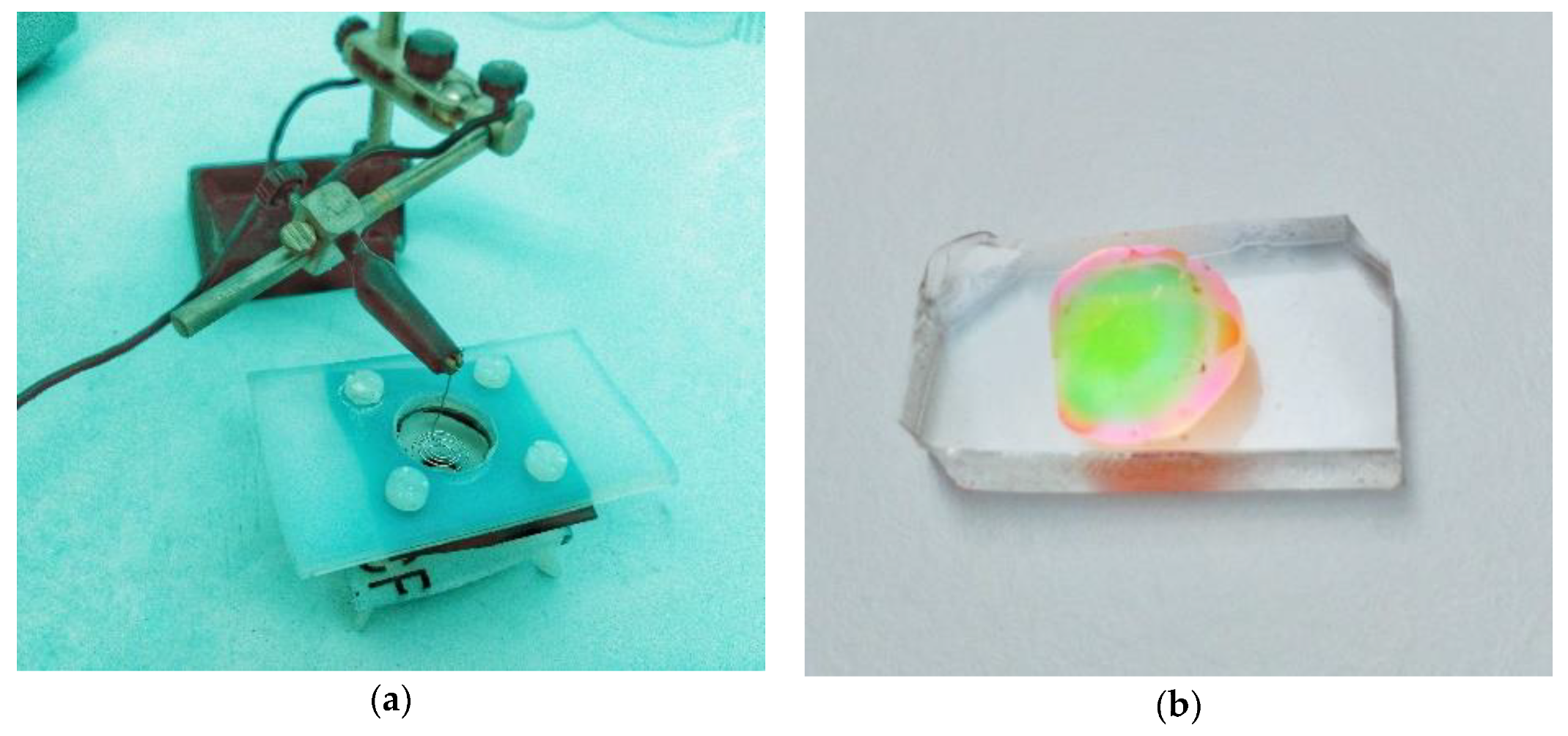Flow-Through Self-Standing Porous Silicon Sensor †
Abstract
:1. Introduction
2. Methods
3. Results and Discussion
4. Conclusions
Funding
References
- Pacholski, C. Photonic crystal sensors based on porous silicon. Sensors 2013, 13, 4697–4713. [Google Scholar] [CrossRef] [PubMed]
- Bisi, O.; Ossicini, S.; Pavesi, L. Porous silicon: A quantum sponge structure for silicon based optoelectronics. Surf. Sci. Rep. 2000, 38, 6–21. [Google Scholar] [CrossRef]
- Kolasinski, K.W. Etching of silicon in fluoride solutions. Surf. Sci. 2009, 603, 1904–1911. [Google Scholar] [CrossRef]
- Zhang, G.X. Porous silicon: Morphology and formation mechanisms. In Modern Aspects of Electrochemistry; Vayenas, C., Gamboa-Adelco, M.E., Eds.; Springer: Boston, MA, USA, 2006; Volume 39, pp. 65–133. ISBN 0076-9924. [Google Scholar]
- Suárez, I.; Chirvony, V.; Hill, D.; Martínez-Pastor, J. Simulation of surface-modified porous silicon photonic crystals for biosensing applications. Photonic Nanostructures Fundam. Appl. 2012, 10, 304–311. [Google Scholar] [CrossRef]
- Agarwal, V. Porous silicon multilayers and superlattices. In Handbook of Porous Silicon; Canham, L.T., Ed.; Springer International Publishing: Geneva, Switzerland, 2014; pp. 153–162. ISBN 978-3-319-05744-6. [Google Scholar]
- Halimaoui, A. Porous silicon formatin by anodization. In Properties of Porous Silicon; Canham, L.T., Ed.; IEEE INSPEC: London, UK, 1997; Volume 12, ISBN 0852969325. [Google Scholar]
- Frohnhoff, S.; Berger, M.G.; Thönissen, M.; Arens-Fischer, R.; Munder, H.; Lüth, H.; Arntzen, M.; Thei, W. Formation techniques for porous silicon superlattices. Thin Solid Films 1995, 255, 59–62. [Google Scholar] [CrossRef]
- Föll, H.; Christophersen, M.; Carstensen, J.; Hasse, G. Formation and application of porous silicon. Mater. Sci. Eng. R. 2002, 39, 93–141. [Google Scholar] [CrossRef]
- Mariani, S.; Strambini, L.M.; Barillaro, G. Femtomole detection of proteins using a label-free nanostructured porous silicon interferometer for perspective ultrasensitive biosensing. Anal. Chem. 2016, 88, 8502–8509. [Google Scholar] [CrossRef] [PubMed]
- Arroyo-Hernández, M.; Martín-Palma, R.J.; Pérez-Rigueiro, J.; García-Ruiz, J.P.; García-Fierro, J.L.; Martínez-Duart, J.M. Biofunctionalization of surfaces of nanostructured porous silicon. Mater. Sci. Eng. C 2003, 23, 697–701. [Google Scholar] [CrossRef]
- Karlsson, L.M.; Tengvall, P.; Lundström, I.; Arwin, H. Penetration and loading of human serum albumin in porous silicon layers with different pore sizes and thicknesses. J. Colloid Interface Sci. 2003, 266, 40–47. [Google Scholar] [CrossRef] [PubMed]
- Lehmann, V.; Stengl, R.; Luigart, A. On the morphology and the electrochemical formation mechanism of mesoporous silicon. Mater. Sci. Eng. B 2000, 69–70, 11–22. [Google Scholar] [CrossRef]
- Haldar, S.; De. A.; Chakraborty, S.; Ghosh, S.; Ghanta, U. Effect of dimethylformamide, current density and resistivity on pore geometry in p-type macroporous silicon. Procedia Mater. Sci. 2014, 5, 764–771. [Google Scholar] [CrossRef]
- Hutter, T.; Horesh, M.; Ruschin, S. Method for increasing reliability in gas detection based on indicator gradient in a sensor array. Sens. Actuators B 2011, 152, 29–36. [Google Scholar] [CrossRef]
- Kovacs, A.; Malisauskaite, A.; Ivanov, A.; Mescheder, U.; Wittig, R. Optical sensing and analysis system based on porous layers. In Proceedings of the 17th International Conference on Miniaturized Systems for Chemistry and Life Sciences, Freiburg, Germany, 27–31 October 2013; pp. 275–277. [Google Scholar]
- Zhao, Y.; Gaur, G.; Mernaugh, R.L.; Laibinis, P.E.; Weiss, S.M. Comparative kinetic analysis of closed-ended and open-ended porous sensors. Nanoscale Res. Lett. 2016, 11, 395. [Google Scholar] [CrossRef] [PubMed]
- Kumar, N.; Froner, E.; Guider, R.; Scarpa, M.; Bettotti, P. Investigation of non-specific signals in nanoporous flow-through and flow-over based sensors. Analyst 2014, 139, 1345–1349. [Google Scholar] [CrossRef] [PubMed]
- Zhao, Y.; Gaur, G.; Retterer, S.T.; Laibinis, P.E.; Weiss, S.M. Flow-through porous silicon membranes for real-time lable-free biosensing. Anal. Chem. 2016, 88, 10940–10948. [Google Scholar] [CrossRef] [PubMed]
- Solanki, C.S.; Bilyalov, R.R.; Poortmans, J.; Celis, J.P.; Nijs, J.; Mertens, R. Self-standing porous silicon films by one-step anodizing. J. Electrochem. Soc. 2004, 151, C307–C314. [Google Scholar] [CrossRef]
- Hale, G.M.; Querry, M.R. Optical constants of water in the 200-nm to 200-μm wavelength region. App. Opt. 1973, 12, 555–563. [Google Scholar] [CrossRef] [PubMed]
- Sani, E.; Dell’Oro, A. Spectral optical constants of ethanol and isopropanol from ultraviolet to far infrared. Opt. Mater. 2016, 60, 137–141. [Google Scholar] [CrossRef]
- Balili, R.B. Transfer matrix method in nanophotonics. Int. J. Mod. Phys. 2012, 17, 159–168. [Google Scholar] [CrossRef]


© 2018 by the authors. Licensee MDPI, Basel, Switzerland. This article is an open access article distributed under the terms and conditions of the Creative Commons Attribution (CC BY) license (https://creativecommons.org/licenses/by/4.0/).
Share and Cite
Martín-Sánchez, D.; Ponce-Alcántara, S.; García-Rupérez, J. Flow-Through Self-Standing Porous Silicon Sensor. Proceedings 2019, 4, 17. https://doi.org/10.3390/ecsa-5-05717
Martín-Sánchez D, Ponce-Alcántara S, García-Rupérez J. Flow-Through Self-Standing Porous Silicon Sensor. Proceedings. 2019; 4(1):17. https://doi.org/10.3390/ecsa-5-05717
Chicago/Turabian StyleMartín-Sánchez, David, Salvador Ponce-Alcántara, and Jaime García-Rupérez. 2019. "Flow-Through Self-Standing Porous Silicon Sensor" Proceedings 4, no. 1: 17. https://doi.org/10.3390/ecsa-5-05717
APA StyleMartín-Sánchez, D., Ponce-Alcántara, S., & García-Rupérez, J. (2019). Flow-Through Self-Standing Porous Silicon Sensor. Proceedings, 4(1), 17. https://doi.org/10.3390/ecsa-5-05717





